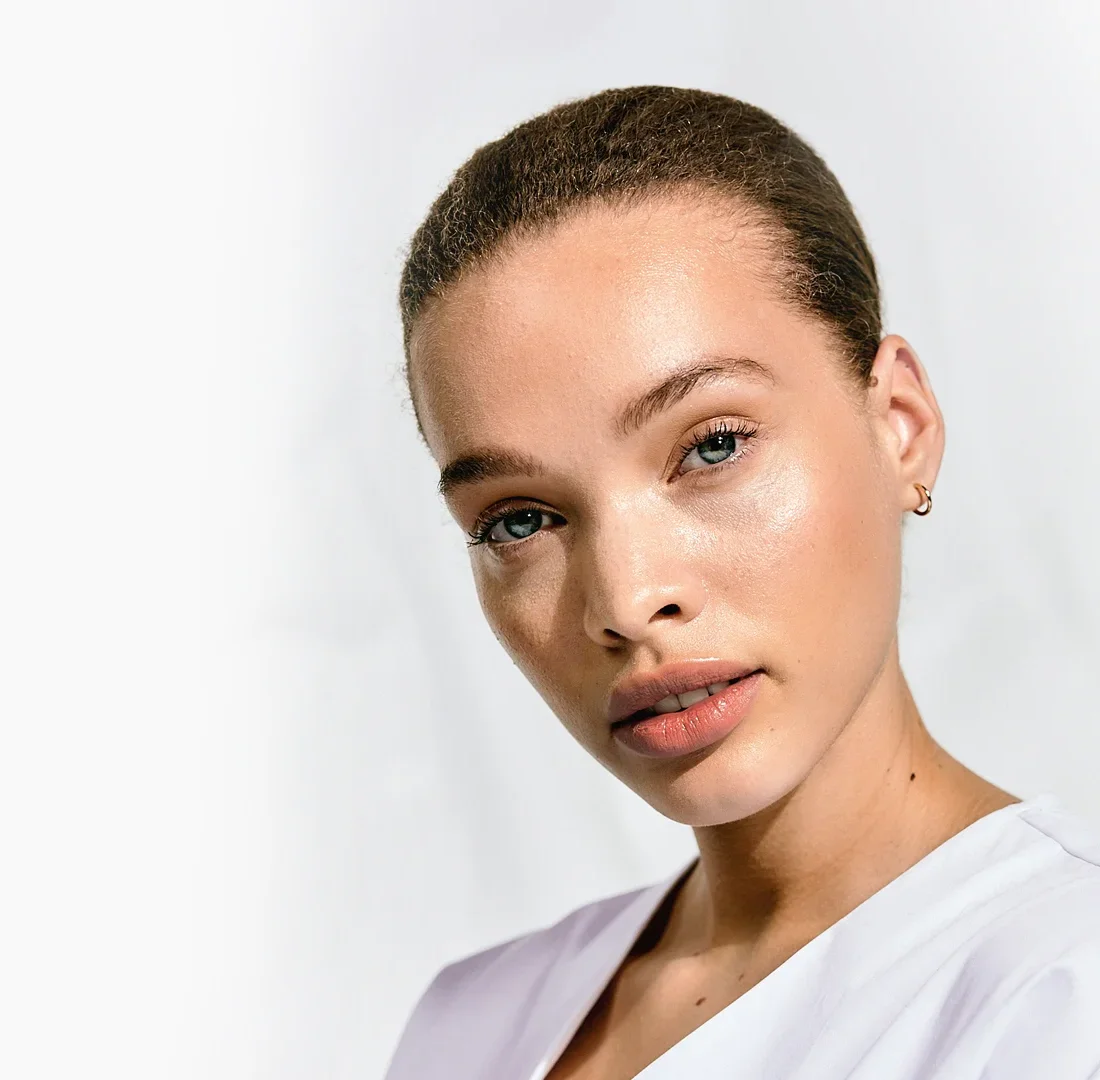YOUR GUIDE TO
DEMYSTIFYING DERMAL FILLERS
Too intimidated to talk about fillers? Don’t worry, it’s not that deep—quite literally! Dermal fillers are injected just below the surface of the skin, often in the middle layer (called the “dermis”) or the fatty layer below it (called the “subcutaneous layer”).12 “Filler” is a catch-all term for products used to create a smoother and/or fuller appearance in the face.7 Learn more about different types of fillers, how they work, and what they can be used to treat.
Actual Belotero Balance (+) patient. Individual results may vary.
AN OVERVIEW OF DERMAL FILLERS
The term “dermal filler” covers a range of products, including medical implants, soft tissue fillers, fillers specifically designed for the lips, fillers for the face, and wrinkle fillers.7 These products can differ on a molecular level. For example, some of the most commonly used fillers are made of hyaluronic acid, which is a naturally occurring component of the skin. Others use different particles, like calcium hydroxylapatite, which add volume below the skin and trigger the body to produce its own collagen in response.13,14
Overall, dermal fillers are used to make the face look smoother and fuller. They can help with lines around the nose and mouth, cheeks, chin, lips, and hands. Some fillers are absorbed by the body over time, so people might need to get the procedure again to keep the look they want.7
The results will depend on the person’s tissue structure and the type of filler used. These factors also affect how long the filler lasts, with duration depending on the filler and where it’s used.7
How do dermal fillers work?
As part of the natural aging process, the face loses subcutaneous fat. Without a fatty “barrier” between the muscles below the skin and the skin’s surface, the activity of the facial muscles becomes more apparent. This results in fine lines and wrinkles in expressive areas of the face.13
In addition to this, skin loses elasticity over time as the body’s natural production of collagen, hyaluronic acid, and elastin slows down.15
Fillers work by building up the volume of the skin, supplementing the subcutaneous fat that naturally occurs below the skin to help diminish facial lines and create fullness in the face.6,13

Actual Belotero Balance (+) patient. Individual results may vary.

What areas can dermal fillers treat?
According to the FDA, dermal fillers can be used in adults aged 21 years and older for the following approved uses7:
- As absorbable/temporary fillers (such as hyaluronic acid fillers) for treating moderate to severe facial wrinkles and skin folds, such as nasolabial folds (lines extending from the sides of the nose to the edges of the mouth) and perioral lines (small wrinkles in the skin around the mouth and lips)
- For increasing the volume of the lips, cheeks, chin, and the backs the hands
- As nonabsorbable/permanent fillers for treating only the nasolabial folds and cheek acne scars
- For correcting the signs of facial fat loss that can occur in people with the human immunodeficiency virus (HIV)
- For contouring wrinkles and acne scars
Actual Belotero Balance (+) patient. Individual results may vary.
FREQUENTLY ASKED QUESTIONS ABOUT BELOTERO BALANCE (+)
Belotero Balance (+) is a hyaluronic acid injectable filler designed to integrate into facial skin tissue. The unique manufacturing process for Belotero Balance (+) yields a soft and cohesive gel that, once injected, instantly fills the skin to help smooth moderate-to-severe etched-in lines and wrinkles in the lower face.1-3,5
While the product is versatile enough to handle moderate nasolabial folds (smile lines), lines around the mouth, and chin wrinkles, it may be an ideal option for treating delicate areas such as etched-in vertical lip lines (thin lines that appear above and around the lips), and under-eye hollows.1,5
Immediately upon treatment, Belotero Balance (+) helps smooth etched-in lines and wrinkles, such as vertical lip lines above and around your lips, as well as under-eye hollows.5
Just as wrinkles and folds vary from face to face, so does the amount of Belotero Balance (+) needed per treatment.5 It’s very individual—it depends on the amount of correction desired, the number of areas to be treated, and other factors. Your healthcare provider can better estimate once you have a consultation about your individual needs.
You can search for a provider in your area using our Find a Provider tool.
While each Belotero Balance (+) healthcare provider determines the cost in his/her own way, Belotero Balance (+) is comparably priced to other fillers. Learn more about how to save on Belotero Balance (+) using the Xperience+ Patient Rewards program.
Belotero Balance (+) is FDA-approved and has undergone testing in a clinical study to demonstrate its safety.
Common side effects include mild irritation, swelling, itching, redness, bruising, and tenderness at the injection site. These side effects typically resolve on their own.5 If any of these side effects persist for more than 7 days, contact your healthcare provider immediately.
There are no clinical trial data for combining Belotero Balance (+) with other products. But that doesn’t mean your provider can’t use Belotero Balance (+) as part of a combination treatment. Belotero Balance (+) uses hyaluronic acid to add volume to the skin. As such, it’s not a regenerative filler in the sense that a product like Radiesse® would be. Radiesse dermal filler can be used to revitalize key components of the skin by stimulating specialized skin cells that promote regeneration.14,16 Talk to your provider about how Belotero Balance (+) and Radiesse can be used to complement one another in a combined treatment plan.
FREQUENTLY ASKED QUESTIONS ABOUT DERMAL FILLERS
After getting dermal fillers, the downtime is usually minimal. Many people can resume their daily activities immediately after the procedure. However, it’s common to experience some temporary side effects like redness, swelling, and bruising at the injection site. These effects typically subside within a few days. It’s essential to follow any aftercare instructions provided by your healthcare professional to ensure a smooth recovery.7,17
The longevity of dermal fillers varies depending on the type of filler used and individual factors. In general, most dermal fillers last between 6 months to 2 years.18
No, dermal fillers do not permanently change your face. The effects of dermal fillers are temporary, and over time, the body gradually absorbs the filler material. The longevity of the filler depends on the type of filler used and individual factors, but most fillers last between 6 months to 2 years.7,18
For dermal fillers, it is essential to see a qualified and licensed healthcare professional who has specialized training and experience in performing cosmetic injectable procedures. The most common types of providers who administer dermal fillers include dermatologists, plastic surgeons, and aesthetic medicine practitioners. Always ensure that the provider you choose has the necessary qualifications, certifications, and experience in administering dermal fillers. It’s essential to have a thorough consultation before any procedure to discuss your goals, potential risks, and expected outcomes.7
The experience of getting dermal fillers can vary from person to person. Some individuals may feel only mild discomfort, while others might experience a little more sensitivity during the procedure. The healthcare professional performing the treatment will usually apply a topical numbing cream or use a local anesthetic to minimize discomfort. Additionally, many dermal fillers contain lidocaine, a numbing agent, which can further help reduce pain during the injection process.18
Dermal fillers and botulinum toxin are both popular cosmetic treatments used to address wrinkles and facial aging. But they work in different ways and target different aspects of the aging process. Fillers involve injecting a substance into or just below the skin to add volume. Similar toxins work by temporarily blocking the nerve signals responsible for muscle contractions. By doing so, it relaxes the muscles, which can reduce the appearance of dynamic wrinkles.19
Some of the benefits of dermal fillers include17,20:
- Smoother, more youthful appearance
- Restored volume and facial contours
- Nonsurgical, quick procedure
Risks of dermal fillers include7:
- Bruising, swelling, or redness
- Allergic reactions (rare)
- Infection (rare)
- Uneven results or lumps/bumps (rare)
- Filler migration (rare)
Ensure treatment by a qualified professional to minimize risks and achieve the best results.7
XPERIENCE BELOTERO BALANCE (+) SAVINGS TODAY
Do you feel like your loyalty is worth something? We feel that way, too, and your loyalty to the Merz Aesthetics Portfolio has value. Learn more about how you can save on Merz products—including Belotero Balance (+)—by earning points through the Xperience+ Patient Rewards program.
See Savings Info